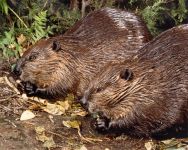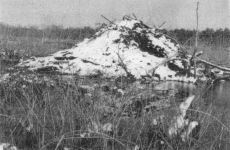


|

|
|
 
|
by Hope Sawyer Buyukmihci, 1994
Published in the February 2013 issue of The Beaver Defenders
When poplar leaves have turned from green to gold, the beavers know that the sap is down and it is time to harvest. One fall I watched the winter food pile grow, as beavers felled trees, cut them into lengths, and towed them to a spot next to their lodge, where they anchored the first ones in bottom mud.
Water is life to a beaver, and without hesitation they plunged head first with butt ends to jam them into the mud. I saw a branched end twitch and whirl as a beaver maneuvered underwater to get the big end of a log firmly planted. At times part of the beaver's fat tail thrashed above the water's surface as he worked.
When the food pile was finished, it consisted of a huge supply of interlaced logs and branches – big logs at the bottom, with branches and leafy twigs piled to above the waterline. Other trees than poplar were mingled in – swamp maple, wild cherry, oak, willow and sassafras.

At about the time food gathering was finished, the beavers started to make their lodge snug for winter. From the bottom they brought up muddy debris. Carrying it clasped under their chins they walked on hind feet up the sides of the lodge, to plaster, repair and fortify. Only at the very top did they leave the traditional air hole of crossed sticks with no mud added.
No sooner had the lodge been readied for winter, when first ice formed, bringing another job. The beavers had four kits that year. Born the first of May, they were seven months old when they saw their first ice. One kit, Fluffy, was more eager than the others. I had often seen him helping his father while the other kits were playing. When the annual job of ice-breaking began, Fluffy was there to help.
One frosty November morning Greenbriar, the father beaver, came swimming up the channel, his progress marked by the crack and tinkling of broken ice. I watched as his head bumped the thin ice from below. As the ice broke, it made a glassy tent over his head. He raised his head high, letting the ice shatter, then placed his front feet on the unbroken portion ahead and pressed. It broke, letting him down with a splash.
He proceeded thus, breaking ice as he came, until he reached the dam on which I was sitting. Paying me no mind (for he knew and trusted me), he turned and went back down the channel, systematically breaking ice along the other side, to widen chunks of floating ice and there was Fluffy, ready to help. He too tried to break ice from underneath, but he was not strong enough.
Next he rose and pressed ice with his small hands, but it would not give way. He tried several times, then with a flourish of his tail he dived under his father and swam ahead, down the channel already opened. For 15 minutes I watched as Greenbriar resolutely opened his channel while Fluffy capered around him in the icy water, trying now and then in vain to break ice as his father did. Once in a while he did manage to break off a section.
Whiskers, the mother beaver, helped with this job too, as she did with everything else, and both beavers kept the water open as long as they could break through the ice. Once the ice became too thick, they retired to their lodge, and I did not see them until an occasional winter thaw which allowed them to come out. Beavers do not sleep the winter away as do hibernating animals. They go to their food pile regularly, bite off pieces of wood with its succulent bark and return to the warmth and dryness of their quarters, under a frozen roof, and above water level. There they live their family life, somewhat curtailed by the weather, but enjoyable nevertheless.
In New Jersey, winter thaws are frequent. Whenever the ice became thin enough to break, beavers emerged. Sometimes they climbed onto the ice carrying a bundle of waterlily roots, which they ate at the ice's edge, ready to leap into cold depths if danger threatened. At other times they ventured into the snow to gnaw on fresh twigs. Often they brought up debris from the bottom and walked with it up the sides of their lodge, making muddy paths in the snow.
At ice breakup each spring, it has been good to see the beaver family come out in force, rollicking and healthy, with shining eyes and glossy fur, after their long confinement. Evidently they have learned a tolerance and adaptiveness that any family might envy.